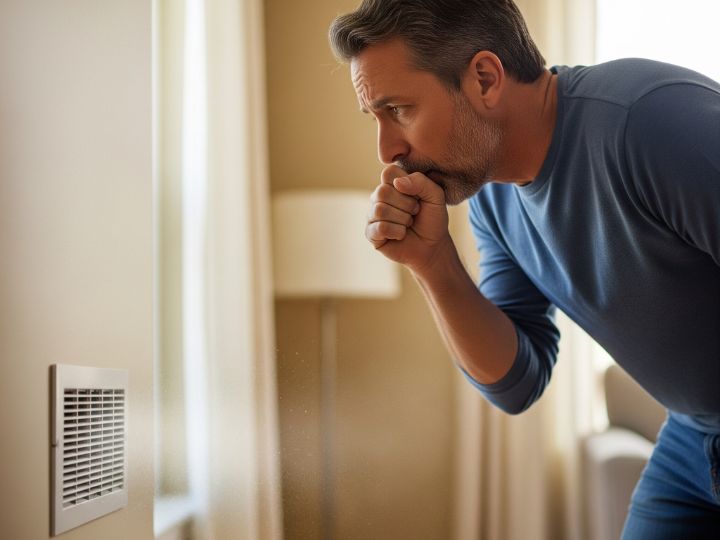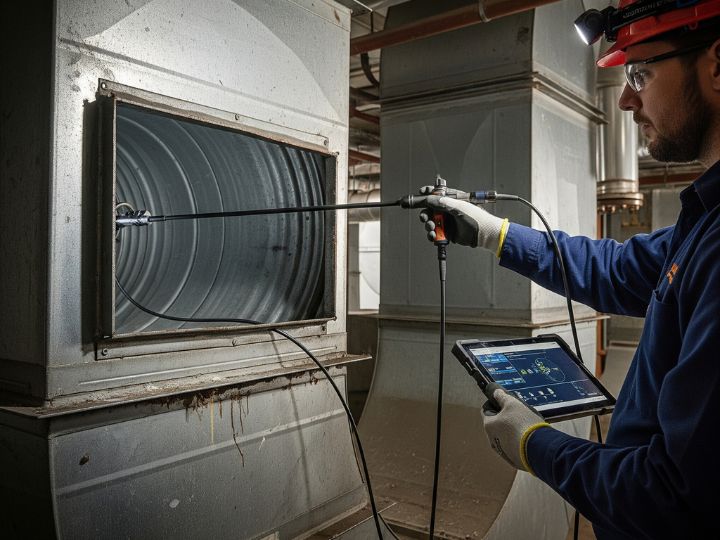Did you know your home’s air ducts could be silently harming your health? Many homeowners overlook the health hazards of dirty air ducts, unaware that dust, mold, and bacteria are circulating every time the HVAC kicks on. Poor indoor air quality can trigger allergies, asthma, and more serious respiratory issues. The health risks dirty air ducts pose are real—and preventable. In this post, we’ll uncover how neglected ductwork can impact your well-being and what you can do to breathe cleaner, healthier air every day. Let’s dive into the dust!
Poor Indoor Air Quality and Its Impact on Health
When air ducts are filled with dust, dirt, pollen, pet dander, and other contaminants, your home’s air becomes polluted and unhealthy. The HVAC system draws in and recirculates air throughout your home multiple times a day, meaning any impurities trapped in the ductwork are constantly being pushed back into your breathing space.
Key health risks include:
- Respiratory irritation
- Sneezing, coughing, and congestion
- Sinus infections
- Allergic reactions
- Worsening of asthma symptoms
Exposure to these pollutants over time can cause even healthy individuals to develop chronic breathing issues, especially in poorly ventilated homes.
Increased Risk of Respiratory Infections
Dirty air ducts are a breeding ground for bacteria, viruses, and mold spores. When these harmful microorganisms become airborne, they can enter the respiratory tract, leading to a range of infections such as:
- Bronchitis
- Pneumonia
- Throat and nasal infections
Children and individuals with weakened immune systems are especially susceptible. Regular air duct cleaning can help eliminate these biohazards and reduce the risk of illness.
Aggravation of Allergy and Asthma Symptoms
For people with allergies or asthma, contaminated air ducts can make indoor air quality intolerable. Common allergens such as dust mites, mold, mildew, and pet dander accumulate in ducts and are distributed throughout the home.
This can trigger:
- Asthma attacks
- Chronic sneezing or runny nose
- Watery or itchy eyes
- Skin rashes or eczema flare-ups
Maintaining clean air ducts is essential for creating an allergen-free environment and reducing dependency on medications. Regular duct cleaning improves air quality, minimizes allergen exposure, and supports better respiratory health for sensitive individuals.
Exposure to Mold and Mildew Spores
One of the most dangerous health hazards associated with dirty ducts is mold growth. When moisture enters the ductwork—often due to humidity, leaks, or condensation—it creates the perfect environment for mold and mildew to thrive.
Mold exposure symptoms include:
- Fatigue
- Headaches
- Breathing difficulties
- Chronic sinus issues
- Cognitive impairments in severe cases
Mold spores are particularly harmful when inhaled regularly, and they can settle deep in the lungs, leading to long-term respiratory damage. A professional duct inspection and cleaning can identify and eliminate mold colonies, restoring safety to your indoor environment.

Circulation of Volatile Organic Compounds (VOCs)
Dirty air ducts can also contribute to the spread of volatile organic compounds, or VOCs, which are chemicals emitted from household products such as cleaning supplies, paints, glues, and aerosols. These toxic compounds settle in ductwork and can accumulate to harmful levels indoors.
Health effects of VOC exposure include:
- Eye, nose, and throat irritation
- Nausea and dizziness
- Liver and kidney damage
- Central nervous system issues
- Increased cancer risk with long-term exposure
Keeping ducts clean ensures that VOCs are vented properly instead of recirculated in your home.
Risk of Pest Infestation and Related Contaminants
Rodents, insects, and other pests often find refuge in dirty, neglected air ducts. They leave behind droppings, fur, dead skin, and even decomposing carcasses, which can seriously compromise air quality.
These pests can spread:
- Hantavirus
- Salmonella
- Allergic reactions from proteins in droppings and urine
Their waste and presence release pathogens and allergens into the ductwork that circulate every time the system runs. Sealing and cleaning ducts helps eliminate pests and the health threats they pose.
Fatigue and Cognitive Issues from Poor Oxygen Quality
Dirty air ducts filled with contaminants can affect oxygen quality indoors. Prolonged exposure to such air can cause:
- Mental fog
- Reduced productivity
- Irritability
- Chronic fatigue
These symptoms are particularly common in environments where ducts are seldom cleaned—like in older homes or buildings with poor HVAC maintenance. Clean air ducts help ensure a balanced, oxygen-rich atmosphere essential for brain and body function.
Worsening of Pre-Existing Health Conditions
If you or your loved ones already suffer from COPD, cardiovascular issues, or autoimmune diseases, exposure to airborne contaminants from dirty ducts can worsen these conditions. Indoor air pollution is a hidden trigger that can elevate symptoms and result in more frequent medical visits and hospitalizations.
Preventive maintenance of your HVAC system, especially ductwork, can help you manage chronic conditions more effectively by ensuring you’re breathing clean, filtered air.
Signs Your Air Ducts May Be a Health Risk
To determine if your duct system could be compromising your health, watch for these warning signs:
- Visible dust buildup on vents
- Musty or foul odors when the HVAC is running
- Sudden or recurring respiratory symptoms
- Mold visible around air vents or registers
- Inconsistent airflow or high energy bills
- Rodent or insect activity near ducts
If any of these are present, it’s time to consider a professional duct inspection and cleaning service.
How Often Should You Clean Your Air Ducts?
To maintain healthy indoor air, it’s recommended to have your air ducts professionally cleaned every 3 to 5 years—or sooner if you:
- Recently completed a home renovation
- Own pets that shed heavily
- Live with allergy or asthma sufferers
- Smell mold or mildew in your home
- Moved into a previously owned home
Investing in routine cleaning not only protects your health but also extends the life of your HVAC system and improves energy efficiency. Many homeowners also pair duct cleaning with air purification services for even better indoor air quality.
Call a Trusted Air Duct Professional: Why 5 Star Air Is the Right Choice

If you’ve spotted visible mold, noticed foul odors, or experienced worsening respiratory symptoms, it’s time to reach out to the pros. Cleaning air ducts isn’t just a DIY task—it requires specialized equipment, expert knowledge, and careful inspection. That’s why homeowners across the region turn to 5 Star Air, a company known for its thorough service, experienced technicians, and commitment to healthy homes.
Whether you’re battling allergens, suspect mold growth, or want to breathe easier, don’t wait. Contact us today for professional air duct and vent cleaning you can trust—because your family’s health starts with clean air.
Final Thoughts: Breathe Cleaner, Live Healthier
The air you breathe at home directly impacts your health—and dirty air ducts can quietly put your well-being at risk. From allergens to harmful toxins, your HVAC system may be circulating more than just cool or warm air. Investing in regular residential air duct cleaning is a smart, preventative step toward a healthier living environment.
To truly optimize indoor air quality, don’t forget your HVAC system’s other components. Combining duct maintenance with AC unit cleaning services ensures a cleaner, more efficient system and a fresher, safer home for everyone.
